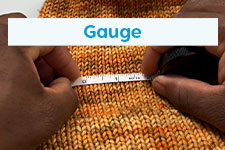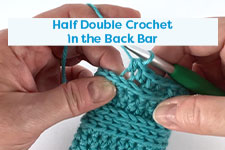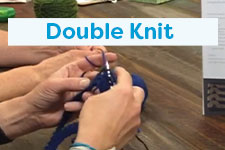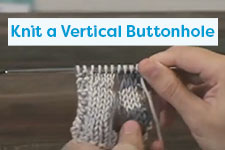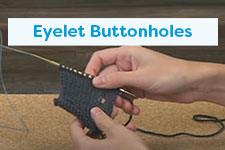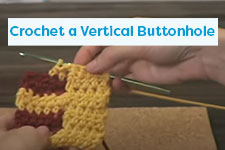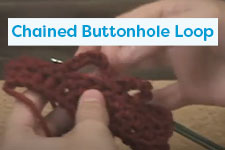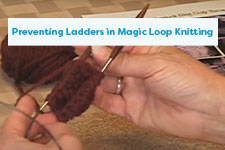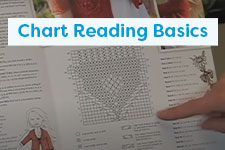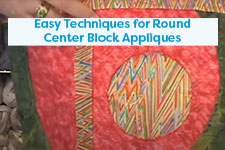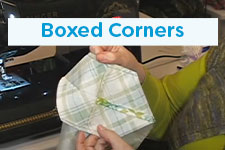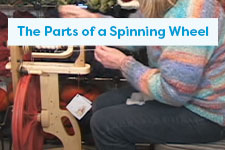Willie from Willie Nillie Knits shows you how to pick up dropped stitches. We hope you enjoy it!
Dropping a stitch from time to time is pretty much inevitable. Despite our best attempts to keep them all on the needles, one seems always to be falling off the front of a straight or circular needle, or off the back of my arch-nemesis, the double point. Luckily, once you've learned to pick up a dropped stitch, it's more of a minor annoyance than a major waste of time. Having pulled out multiple rows and re-knit them time and time again, I'm delighted now that I've learned how to fix dropped stitches without backtracking.
 | The first step to being able to fix your dropped stitches is being able to identify them. Each stitch on your needle is a loop, attached to the row below it by looping through the stitch below. So when a stitch falls off your needle, it first looks like a little loop right at the top of your knitting - if you can pick it back up right away, that's all there is to it! With the loop safely restored to the company of its brothers on your needle, you're ready to start knitting again. |
 | The real problem comes when you can see the same little loop that you did at the top, but now it's a row, or two...or ten, down from where you're knitting now. Sometimes, when the stitch has had some time to pull down several rows, instead of seeing the stitch at first you just see a ladder of straight sections of yarn. Don't be overwhelmed by dread! This is fixable, and you don't have to take out your whole piece just to recover that one stitch. |
If you see a dropped stitch ladder, the first thing to do is find the loop at the bottom. There will always be one - unless unluckily the stitch has made its way all the way down to where you cast on. If your ladder ends at the bottom of your knitting and there's absolutely no loop to be seen, you may want to pull it all out after all. It is definitely possible to reconstruct your cast on stitch and work back up through all those rows, but it is a little more complicated than just bringing the stitch back up through your knitted rows. Fortunately, most of the time that doesn't happen - you usually have to yank on the piece sideways with a good deal of force to pull out the cast on...so just don't play tug of war with your knitting until after you've picked up your dropped stitch, and you should be all set.
 | If your stitch has gone any distance other than all the way to the end, you can still fix it. First find the loop. It may be very small at the moment if it's in the process of pulling through another row, but once you start pulling it back up one more row will hardly matter, so don't worry if your first attempts to get your needle through it cause it to drop another step in the ladder. Just get your needle through the loop, in any direction to start with. Once you've caught the loop, your work is safe. If you need to put it down now (or maybe put it in a cupboard for a year or two), there's no problem - it will be just the same when you come back to it, for better or worse. |
Next is bringing the loop back up to its proper row. You can figure out how many rows you have to work by looking in front of and behind the loop that you've caught on your needle. Count the number of times that the yarn goes straight behind and in front of your loop - these are the steps of the ladder that your stitch has created, and this is the number of rows that you need to work back up. In the photo, I'll need to bring the loop back up a total of 5 rows.
Make a note of whether the knit or purl side of the work is facing you. This will determine which way you re-hook the loop. When you knit on both sides of your work (i.e. garter stitch) and then you look from one side, you see the front of one row and then the back of another, alternately (the purl is the back of the knit). In this case, you'll be re-hooking one stitch knitwise and then one purlwise.
 | If the knit side of the work is facing you, put your crochet hook into the loop from your side toward the back of the work. Maneuver things so that your loop is sticking out the front of your work, in front of all the steps of the ladder that you need to work back up. |
 | Hook the first step of the ladder, and pull it through your loop from back to front. Drop your original loop off the hook, keeping the stitch that you just created from the step of the ladder. |
 | Voila! You're one row closer to your goal. I had five steps in the ladder when I started, and now I have only four. |
Repeat this until there are no more steps in your ladder, then slip your stitch back onto whichever needle it slipped off. If when you knit it in the next row, that stitch looks twisted, knit it through the back - its direction may have gotten switched during the re-looping.
If the purl side of your work is facing you, you have two choices: you can turn the piece over so the knit side is facing you and follow the directions above, or you can do the same hooking, backwards. If you're knitting garter stitch, it will probably be easier to do this than to turn the work over for each row.
 | To re-hook from the purl side: Maneuver your loop so that the steps of the ladder are in front of it. Reach through your loop from back to front, hook the first step, and draw it back through the loop to create your new loop. Repeat, as above. The only disadvantage to doing it this way is that the steps of the ladder block your view of what you're doing - in the photo, the purl side is toward me, but it's kind of facing down so the picture can show what I'm doing behind the work. |
If you're knitting garter stitch, you'll be alternating knit and purl rows. It can be difficult to decide which one to start with if you're not sure which stitch is which - I think the easiest thing is to try one, say the knit, first, and if the stitch you create looks different than the ones next to it in its row, take it out and try the purl.
How to pick up stitches with just your needles - no crochet hook needed!
| |







